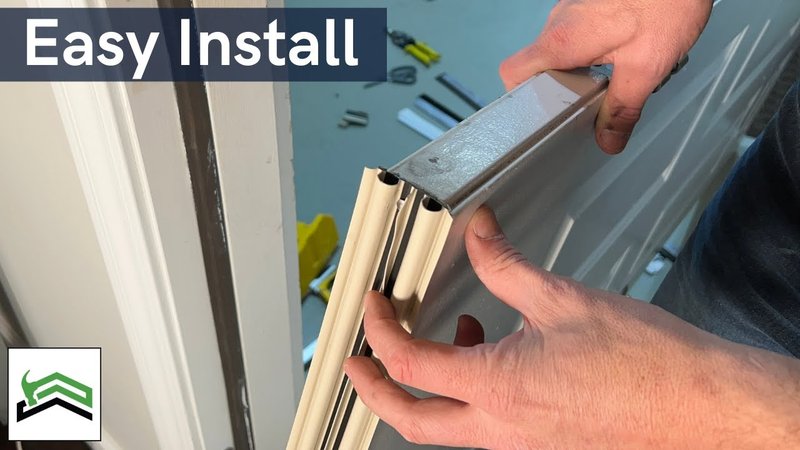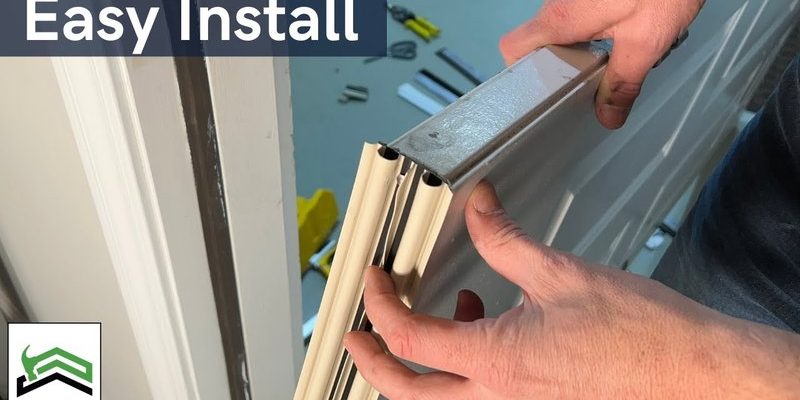
Honestly, fixing a door seal that doesn’t compress right isn’t glamorous work. But it’s something almost everyone faces at some point, whether you’re dealing with an old wooden front door or a fancy modern refrigerator. If you’re here, you’ve probably noticed a stubborn draft, extra noise, or a mystery puddle—maybe after you’ve just replaced the seal, only to find the problem’s still there. No shame! It happens more often than you’d think, and the good news is, most issues have clear causes and simple fixes.
Here’s the thing: door seals work in a pretty straightforward way, but there are several reasons why they might not do their job. Once you know what to look for, troubleshooting isn’t rocket science—you just need a careful eye and a little patience.
How Door Seals Are Supposed to Work
Let me explain: a door seal, sometimes called weatherstripping, is designed to create a tight barrier between your door and its frame. When you close the door, the seal should get squished—compressed—enough to block air, water, dust, or sound. If you’ve ever opened a fridge and heard that little hiss, that’s the seal releasing its grip.
A good seal is like a handshake. Too loose, and you let in all the unwanted stuff. Too tight, and the door’s hard to close or even risks damaging the seal over time. Most modern door seals are made from rubber, silicone, or foam. Some car doors use special compression gaskets, and many exterior doors have a bulb or blade-style weatherstrip.
Why does compression matter so much? Without compression, there’s literally a gap—sometimes you can even see light peeking through! This is a big deal for climate control (think: drafty rooms or high energy bills), security, and keeping bugs or moisture out. Even in cars or appliances, a bad seal means reduced efficiency, more noise, and possibly bigger repair bills down the line.
Understanding how these seals *should* work is the first step in troubleshooting why yours isn’t compressing when closed.
Common Reasons Door Seals Don’t Compress Correctly
You might be wondering, “Why won’t my door seal squish like it’s supposed to?” The answer usually falls into a few categories:
- Worn-out or flattened seal: Seals can lose their springiness over time, especially with lots of use or exposure to the elements. Check for areas that look thin, cracked, or permanently squished.
- Misaligned door or frame: If the door doesn’t sit perfectly in its frame, it may not press evenly on the seal. Even a minor sag or warp can leave you with uneven compression or none at all.
- Improperly installed seal: Sometimes, a new seal isn’t seated deeply enough or is the wrong size for your door. The material should line up with the part of the door that actually makes contact with the frame.
- Damaged or missing hardware: Broken hinges, loose screws, or misaligned strike plates can keep a door from shutting as snug as it should.
It’s amazing how a tiny misalignment or a cheap, worn-out seal can throw off the whole door’s performance. Don’t overlook the basics!
Taking a close look at these areas will usually give you a solid clue about what’s going wrong.
How to Check If Your Door Seal Is Really the Problem
Before you go buying a new seal or calling in a pro, there are a couple of easy tests you can do to confirm the issue.
- Visual inspection: Close the door and look for any visible gaps between the seal and the frame. A flashlight shone from the other side can help. If you see light, air will travel through, too.
- Paper test: Place a strip of paper or dollar bill in the gap, then close the door. Try to pull it out. If it slips out easily, the seal isn’t compressing well in that spot. Repeat along the length of the seal.
- Feel for airflow: On a breezy day, run your hand along the edges. If you feel a draft, the seal isn’t tight enough.
Here’s the thing: sometimes what looks like a door seal problem is actually a frame or alignment issue. So, pay attention to whether the gap is all along the door or just in one spot. If it’s just the bottom or the latch side, you may need to tweak the hardware rather than just replace the seal.
If you’re dealing with a car door or refrigerator (like a Whirlpool or GE model), try the same paper test. Many appliance techs use this trick to spot a bad seal before suggesting a replacement.
Fixing a Door Seal That Won’t Compress: Step-by-Step Solutions
Ready to do something about it? Here’s a simple process to get your door sealing tight again:
1. Clean the seal and surface:
- Dirt, grime, and old adhesive can stop a seal from sitting flat. Wipe everything down with warm, soapy water and let it dry.
2. Check for damage:
- Look for cracks, tears, or spots that have lost their bounce. If the seal is brittle or missing chunks, it needs replacing.
3. Adjust the door or frame:
- Try tightening loose hinges. If the door has dropped, you might need to shim a hinge or adjust the strike plate. For cars, make sure the latch catches smoothly.
4. Reinstall or replace the seal:
- If the seal was recently installed, make sure it’s seated fully in its groove or track. Use the correct code or part number (especially for cars, refrigerators, or branded entry doors).
- If it’s an old seal or doesn’t match, swap it for one that fits your door model—and make sure it’s oriented correctly.
5. Test again:
- Close the door and repeat the paper test. The seal should now grip the paper all the way along. Double-check for airflow or noise leaks.
This step-by-step covers most brands and types, from basic home doors to heavy-duty appliances. If you’ve got a universal door seal or a specialty brand like Andersen, Therma-Tru, or a car make, always check for any specific install instructions or codes before trimming or fitting the new seal.
How to Choose the Right Replacement Door Seal
Picking the right seal isn’t just about grabbing the first one off the shelf. Honestly, using the wrong size or material is one of the most common causes of seals not compressing right.
Here’s what you need to compare:
- Material: Rubber is the most common—flexible and durable. Silicone is good for extreme temps and won’t crack as quickly. Foam is cheaper but often less durable.
- Size: Measure your old seal width, depth, and length. Too thick, and the door won’t close right; too thin, and you’re back to square one with gaps.
- Profile: Some doors use a bulb (rounded), blade (flat), or even special magnetized types (fridges). Match the style to your original for best results.
- Compatibility: Some seals are “universal,” but many brands—especially with cars, fridges, or high-end doors—need a specific code or part number to fit and compress correctly.
Don’t guess—bring your old seal or snap a photo to compare at the store or online. When in doubt, look up your door or appliance model for recommended replacement codes.
If you’ve got a unique door or live somewhere with tough weather, upgrading to a higher-quality or more weather-resistant seal can be worth the extra cost and effort.
Alternatives if a New Seal Still Doesn’t Work
Sometimes you do everything “right” and still end up with a door seal that refuses to compress. Maybe the door frame has warped, or the door is just old and no longer square.
Here are other options to consider:
- Add a secondary seal: Sometimes layering a thinner adhesive foam strip inside the main seal area (for example, on the door stop) can help fill minor gaps.
- Adjust or repair the frame: For wood doors, humidity can change the shape over time. A little sanding, planing, or realignment can make a big difference.
- Consider a new door or frame: If the door is badly warped, no seal in the world will fix the issue completely. Sometimes, especially for old exterior doors, replacement is the best long-term fix.
- Call a pro: If you’ve tried all the troubleshooting steps and still aren’t getting a good seal, a carpenter or locksmith has the tools and experience to track down tricky alignment problems.
Trust your gut: if it seems like you’ve done everything and the seal *still* isn’t compressing, the problem might be bigger than a simple weatherstrip.
Why Fixing Your Door Seal Matters—More Than You Might Think
It’s easy to shrug off a weak door seal as a minor nuisance, but over time, it actually causes a bunch of issues:
- Energy loss: Gaps let in cold or hot air, making your heater or AC work overtime (which hits your wallet, too).
- Extra noise: A loose seal means every honk, bark, or passing conversation comes through loud and clear.
- Moisture and bugs: Gaps can invite water damage, mildew, or a parade of insects if left unchecked.
- Security: In some cases, a door that won’t shut tightly is also easier for would-be intruders to open with a little force.
Even with high-end brands—whether it’s your front door, a luxury SUV, or your kitchen’s best refrigerator—a seal that doesn’t compress right can ruin the whole experience. Fixing it now saves headaches (and cash) down the road.
When to Call in a Professional
Some DIY fixes are straightforward, but there are times when troubleshooting a door seal that’s not compressed when closed turns into a bigger job than expected. If you notice major frame damage, feel the door dragging, or find that you need to code, sync, or reset smart-lock hardware, it might be time to bring in help.
A professional can:
- Identify alignment issues you might miss
- Install specialty seals (like magnetic or double-bulb systems) for top brands
- Deal with code-matching for car or appliance door seals that require precise fit
- Ensure everything is paired and working if your door has integrated tech
For most home doors and even standard remotes or appliances, DIY is fine. But if you’re ever stuck, no shame—pro help means the job gets done right, and your seal actually *compresses* the way it’s supposed to.
Tying It All Together
If your door seal isn’t compressing when the door’s closed, you’re definitely not alone. From misaligned frames and tired old seals to wrong-size replacements, most issues can be tracked down with a little patience and a good eye for detail. Taking time to test, adjust, and (if needed) replace that stubborn seal makes your space quieter, cozier, and safer. Plus, you’ll save yourself the annoyance of another cold draft or mystery puddle.
Troubleshooting a door seal that’s not compressed when closed isn’t glamorous, but it’s practical—and once you get it right, opening and closing your door just feels better. So grab that flashlight, run a few tests, and get your door sealing like new again.
